UK golf industry in drive
The golf business suffered during the global economic downturn of 2008, with playing seen by many as a non-discretionary leisure extra, and registered player numbers in Scotland and England have declined over the past decade, hence initiatives like the golf month.
And KPMG, in its recent Golf Participation Report for Europe 2016, points to a game in seemingly healthy condition in England and Scotland.
Image caption England and Scotland have among the highest proportions of golf courses in Europe “Both [sports organisations] England Golf and Scottish Golf Union are promoting a number of targeted programmes to improve the state of golf, and are seeing improvements at county levels through various initiatives,” KPMG’s Golf Advisory unit says.
 In fact, England still has the most registered golfers and most courses in Europe, accounting for 16% of all registered players across the continent, and is home to more than a quarter of all European golf courses.
In fact, England still has the most registered golfers and most courses in Europe, accounting for 16% of all registered players across the continent, and is home to more than a quarter of all European golf courses.
According to KPMG, England reported a decline of 2.4% in registered players in 2015, while Scotland recorded a drop of 0.8%, although it may be that golfers prefer to play on an increasingly ad hoc basis, paying for golf per round rather than registering with a club or course.
And, although England remains the biggest European golf market, in 2015 the English Golf Union (EGU) reported a decrease in numbers of six courses over the year.
“The gender split in the UK among golfers is quite one-sided,” it says, “with females representing only 15% of all participants, and 15% of members at UK golf clubs.
An initiative, This Girl’s Golf, was launched in 2015, to change female perception of golf and encourage participation.
Mr Freemantle is keen to point out that golf is already adapting, with participation being more than just the traditional 18-hole round, with other forms of activity such as the driving range, 9-hole rounds, adventure golf, and pitch and putt also proving popular with new participants.
